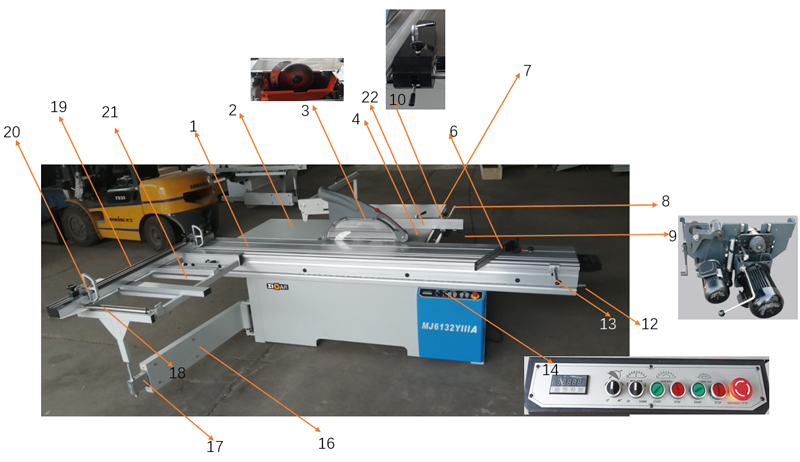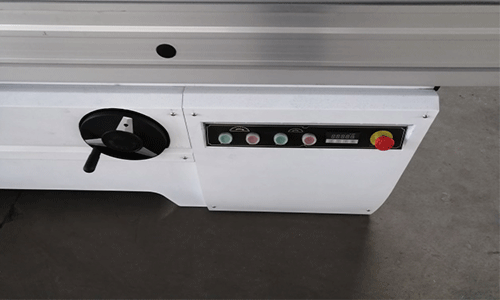Safety Accidents Preventive Measures of Sliding Table Saw
If you’re looking for a production saw to produce panel furniture, sliding table saws are a great option. They deliver precise cuts and are often considered the gold standard when it comes to production saws. Mastering performance and achieving high-quality, efficient and safe production is the primary issue for enterprises to consider.
The role of sliding table saw and common safety accidents
Sliding table saws are mainly used in the following aspects in the production of panel furniture:
(1) Cutting material: When large furniture factories have panel saws, sliding table saws are used for panel cutting or auxiliary panel cutting;
(2) Material cut: cut off the small-sized parts;
(3) Grooving: It is mainly used for grooving the bottom of the drawer, the back panel and the edge of the wooden frame glass door;
(4) Saw angle and processing bevel: complete special-shaped and bevel processing according to the personalized furniture design scheme.
Due to the exposed tools and manual operation of the sliding table saw during use, industrial accidents frequently occur, and it is a key management equipment for furniture manufacturing factories.

The main safety accidents that are prone to occur in actual production are as follows:
(1) Finger injuries during sawing;
(2) The phenomenon of “flying board” caused by the clamping saw or uneven feeding force during the feeding process;
(3) Damage to the saw blade and the operator caused by the metal objects in the inferior plate during the sawing process;
(4) Fatigue production leads to injuries caused by hands entering the danger zone. The reasons for the above-mentioned work-related injuries are the defects in the design of the machinery itself, and the improper operation of the workers.
※ Analysis of the causes of safety accidents
2.1 Division of working area of sliding table saw
The working area of sliding table saw is generally divided into safe area, critical area and injury area. The safety zone refers to the working range of the operator’s safe operation; the critical zone is the range where potential personal injury may occur; the injury zone is the dangerous range where injury will definitely occur. The damage zone is equivalent to the range of the protective cover, where the sensors that detect dangerous situations in foreign sliding table saws are placed. The two leading areas of the shield are part of the danger zone. In order to sense high-speed motion in a timely manner, the leading edge area needs to be used as a buffer. With the buffer, there is hand reaction time and the necessary response can be made.

2.2 Analysis of the causes of hand injury accidents
Combined with many years of production experience in furniture factories, also combined with the investigation of Fulaiweier Furniture Manufacturing Co., Ltd. and other factories, the main reasons for the operator’s hand injury are as follows:
(1) The feed speed is too fast: the feed speed exceeding 0.67m/s is a dangerous speed (the upper limit of the feed speed during ordinary sawing operations is 0.67m/s). In addition, movement parallel and perpendicular to and towards the saw blade is also dangerous.
(2) Machining accuracy: The machining accuracy of furniture parts is generally ±0.5mm. One-sided pursuit of machining accuracy, fingers working in critical areas and dangerous areas for a long time, may lead to finger injuries.
(3) The phenomenon of “flying board”: the consequences are quite serious and may cause casualties. The root cause is the “clamping saw”. When the sliding table saw is normally sawing wood-based panels, it will not produce “clamp saw” due to the stability of the board material, but if the position of the guide ruler is not adjusted correctly, the front end is too long, and “clamp saw” will occur when the feed force is large. “And may lead to “flying board” phenomenon.
(4) “Crack tooth” phenomenon: wood-based panels generally do not contain metal debris. However, there are occasional metal debris in a very small number of plates and inferior particleboards, which can damage the saw teeth and fly out during the sawing process, causing injuries to the operator.
(5) “Fatigue” phenomenon: the work content of the operator is relatively simple, the working time is long, and it is easy to produce fatigue, and the two saw blades rotate at high speed, the scribing saw blade is highly concealed, and a very random action can be There is a possibility of injury.
Safety accident prevention measures and new safety technology of sliding table saw
※ Safety measures based on existing conditions
At present, the sliding table saw produced by the manufacturer pays more attention to the processing accuracy and durability of the equipment, and does not pay enough attention to safety. In terms of safety devices, there is not much improvement outside the conventional protective cover, feed knife, and emergency brake switch; there is no breakthrough in the monitoring device of the danger zone. To achieve safe production under the existing equipment conditions, the following aspects can be considered:
(1) Pay attention to the adjustment and maintenance of the sawing machine: Regular cleaning of the machine can prolong its service life, ensure a good sawing effect, and improve the safety of equipment operation. The main attention should be paid to the fixed table, slide table guides, the rubbing surfaces between the relative movement of the rotary plate and the pendulum plate when the main saw blade is lifted, and the two arc guide rails. The height of the table should be about 850mm , which is conducive to standardized operation.
(2) Pay attention to the operating specifications: Before starting the machine tool, you must carefully check whether the saw blade chuck, the nut and the screws of each part are tightened; the saw machine does not allow the saw blade to work without a protective cover; when installing the saw blade, pay attention to The cutting direction should not be reversed; when manually feeding, the wood must be close to the worktable and the backing board, and the hand should not be close to the saw blade. The force of the push table should be uniform, and it should not be pushed and pulled violently; more than two people operating the machine tool should coordinate with each other, and pay attention to each other’s safety; auxiliary workers should not stand in the cutting direction facing the saw blade, and pay attention to safety when collecting wood.
(3) Avoid long-term fatigue operation and achieve relaxation.
(4) In order to avoid the injury of iron filings, it is recommended to wear safety goggles.
3.2 Development Trend of New Safety Technology of Sliding Table Saw
The basic working principle of the more advanced sliding table saw safety device currently on the market is that when the operator’s body touches the saw blade, the saw blade should be able to quickly brake and swing away quickly. The disadvantage of this safety device is that the selected hand recognition device must touch the saw blade. When the feed speed is 6m/min (0.1m/s), it may cause a 1mm wound; when the feed speed is increased to 2m/s, the wound depth may increase to 20 times. In addition, the direct braking of a high-speed rotating saw blade with a large mass in a short period of time may damage the saw blade, and the flying saw blade fragments may cause significant injury to the operator.
The more advanced precision table saw developed abroad is equipped with a dangerous area monitoring device, which consists of the following parts:
(1) Camera device;
(2) Sensor and protective cover with safety plate;
(3) Hazard warning lights. Among them, the camera device with data processing can provide relevant information about the movement of the operating hand; the sensor is composed of infrared sensor and capacitive sensor, which is used to monitor the danger zone. The pyroelectric infrared sensor consists of two different metals and has a response time in the millisecond (ms) range, suitable for detecting hand movement speeds of up to 2m/s. To detect human hands reliably, capacitive sensors are used. Its working principle is based on detecting the change in capacitance between two electrodes. Human tissue contains more than 70% moisture and therefore has a much larger permittivity than dry wood, and by properly evaluating the change in capacitance, wood and human hands can be distinguished.
The infrared sensor is installed on the protective cover, and the capacitive sensor is installed under the safety plate, which is to reduce the distance between the measured object and the sensor to reduce errors. The safety plate is fixed on the protective cover and is a part of the protective cover. When a foreign object enters the front of the danger zone, the warning light installed on the protective cover flashes, which reminds the operator that his hand may be directly injured. The above monitoring device is installed on the precision push table saw with the saw blade braking device, and the combination of the two can ensure that the operator will not be hurt.
The application of sliding table saw improves production efficiency and processing accuracy. Therefore, in addition to strengthening worker training, there should be breakthroughs in the safety devices of the equipment, and ultimately achieve real safe production.
Related Products:






